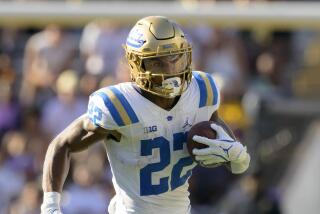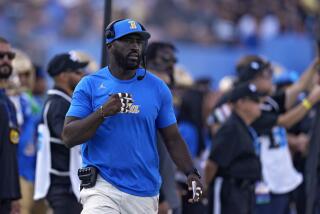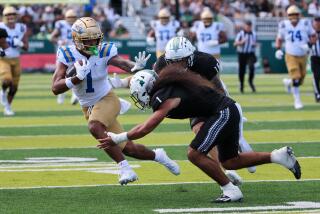Sun Devil Kids Take On Wolverine Tradition : Game Is a First for Pac-10 Winners, but Otherwise, All Seems Fairly Equal
On one sideline, we have the University of Michigan, which has one of college football’s richest traditions.
The Wolverines have played in 11 Rose Bowl games, including the first one in 1902, when they beat Stanford, 49-0. This is the 12th consecutive year Michigan has been to a bowl game.
On the other sideline, we have Arizona State University, which fielded its first varsity team in 1897, only 18 years after Michigan.
But the Sun Devils didn’t go to a bowl game until 1940, when they played to a scoreless tie in the Sun Bowl against Catholic University. They returned the next year and lost to Western Reserve.
Their next two postseason games, both in the Salad Bowl, also resulted in losses, the last one to Woody Hayes’ Miami of Ohio Redskins.
In all, the Sun Devils have been to 13 bowl games, but only 4 of them have been outside greater Phoenix.
Today, however, in the 73rd Rose Bowl game, fourth-ranked Michigan (11-1) and seventh-ranked Arizona State (9-1-1) will face each other as equals, at least until the kickoff (2 p.m., Channel 4).
Michigan is favored by a couple of points, although Arizona State Coach John Cooper said he believes his team may have a slight advantage because it has played in the Rose Bowl in each of the last two seasons, winning there in October against UCLA.
But he admitted this week that there probably is a difference in playing in the Rose Bowl and in the Rose Bowl.
Since Arizona State and Arizona joined the Pacific 10 Conference in 1978, this is the first time either has earned a Rose Bowl berth. The Sun Devils will discover soon if they are ready-for-primetime players.
“No question I’ll have butterflies and be very uptight,” Cooper said. “Our players will be the same way.
“We have to feel our way around for the first few minutes, then settle down and play like we’re capable of playing.”
But neither is Michigan an experienced Rose Bowl team. Even though this is the eighth time the Wolverines have been to the Rose Bowl with Bo Schembechler as their coach, none of these particular Wolverines have ever played in one of the games.
The fifth-year seniors were on the sidelines as redshirt freshmen in 1983, but they weren’t allowed to play.
Michigan lost that game, 24-14, to UCLA, giving Schembechler a 1-6 Rose Bowl record, which he has made sport of in recent weeks.
When Cooper said during a press conference early last month in Pasadena that he needed advice from Schembechler on preparing a team for the Rose Bowl game, the Michigan coach laughed and said: “I can’t help you, Coach.”
With apologies to their fight song, the Wolverines have not been champions of the West.
On the positive side, Schembechler’s one Rose Bowl victory is one more than all of the other current Big Ten coaches have combined. Michigan’s 23-6 victory over Washington in 1981 was the Big Ten’s last in the Rose Bowl.
While the Pac-10’s Rose Bowl advantage over the Big Ten is only 21-19, 15 of the last 17 winners, and 11 of the last 12, have come from the Pac-10.
The Pac-10 has won three of the last five games by lopsided scores, the most recent a 45-28 UCLA victory over Iowa last Jan. 1.
Among the numerous theories for the Pac-10’s advantage, the one most often advanced is that most of its team play on natural grass, which the Rose Bowl has, while all Big Ten teams play on artificial turf.
At the Rose Bowl press conference in early December, Schembechler elaborated.
“We think we have speed and quickness,” he said, speaking for Big Ten teams. “But we come out here and play teams that have the same speed on natural grass that we have on artificial turf.
“When we come out here, we slow down a little bit. Maybe we have an exaggerated opinion of our quickness.”
This week, however, Schembechler was in no mood for excuses.
“There are 1,000 excuses, from playing surface to the distance we have to travel,” he said. “When it all boils down, it’s a lot of hogwash.
“We’re not little Sammy Milquetoast. We don’t have to play at home to win.
“If they (the Pac-10) beat us again, damn it to hell, we’ll all be mad. But there’s no use coming up with all these excuses.
“I’m not going to worry about it, although I should. I’m the worst guy.”
Cooper dismisses the issue by saying that most of the advantage has been built with victories by USC and UCLA, which virtually are home teams.
But if beating USC and UCLA in their own backyards is such a difficult task, then the Sun Devils are marvels because they did it twice this season. They beat UCLA, 16-9, at the Rose Bowl and USC, 29-20, at the Coliseum.
Arizona State came within one victory of a Rose Bowl berth last season, Cooper’s first, but he said the Sun Devils made it this time because they were more conservative, which is his style.
Cooper believes in defense first.
His defense this season allowed an average of 13.8 points.
Cooper preaches error-free offense.
While his offense led the conference in yardage gained and averaged 32.5 points, it lost only 4 fumbles and had 15 turnovers.
Of senior quarterback Jeff Van Raaphorst’s 11 interceptions, 5 came in one game, an early season 21-21 tie with Washington State.
Van Raaphorst was benched in that game but came back to throw 103 consecutive passes without an interception.
“When I looked out on the field in the Washington State game and saw somebody playing where I should have been, it was pretty frustrating,” he said. “I figured right then and there I didn’t want to spend the rest of my senior year on the bench.
“I was trying to make the big play too often instead of throwing to the open receiver. I was trying to force the ball 20 yards instead of taking the short gain.”
Van Raaphorst had protection from one of the nation’s most distinguished offensive lines, including 6-6, 293-pound senior tackle Danny (Pancho) Villa, the only Associated Press first-team All-American in this game.
While Van Raaphorst led the Pac-10 in passing efficiency, Michigan senior quarterback Jim Harbaugh was second in the nation.
“He completed 66% (65.7) of his passes, but the great stat in my mind is that he threw only 9 interceptions,” Cooper said.
Harbaugh was third in Heisman Trophy voting, but Schembechler talks as if he wouldn’t trade his quarterback for the winner, Miami’s Vinny Testaverde.
Led by Harbaugh and 5-7, 179-pound junior tailback Jamie Morris, little brother of the New York Giants’ Little Joe Morris, the Wolverines averaged 30.3 points.
The defense allowed an average of 15.1, good except when compared to last season’s defense, which allowed only 8.1 points a game.
This Michigan team probably isn’t as good as the 1985 team, which lost to conference champion Iowa by a field goal on the last play of the game.
“In some areas, we’re not as strong as we have been in the past, but I like this team,” Schembechler said. “They know how to win.”
Both coaches said they believe their teams will win. Both said the difference will be the kicking game. All coaches say that, but, in this case, it would be best to pay attention when Michigan punter Monte Robbins is in the game.
The Wolverines led the nation in net punting, the length of the kick minus the return yards, with a 44.1 average. But the Sun Devils led the nation in punt returns with a 17.9 average.
Both team have accurate place-kickers from inside 40 yards, but Michigan’s Mike Gillette is better from longer distances than Arizona State’s Kent Bostrom.
Cooper believes he has solved that.
“I’ve heard the home team gets to suit up the grand marshal of the Rose Parade,” he said at the Rose Bowl luncheon Wednesday.
“When we’re facing fourth and a mile, we’re going to send him in to kick a touchdown.”
The grand marshal is Pele.
More to Read
Go beyond the scoreboard
Get the latest on L.A.'s teams in the daily Sports Report newsletter.
You may occasionally receive promotional content from the Los Angeles Times.









